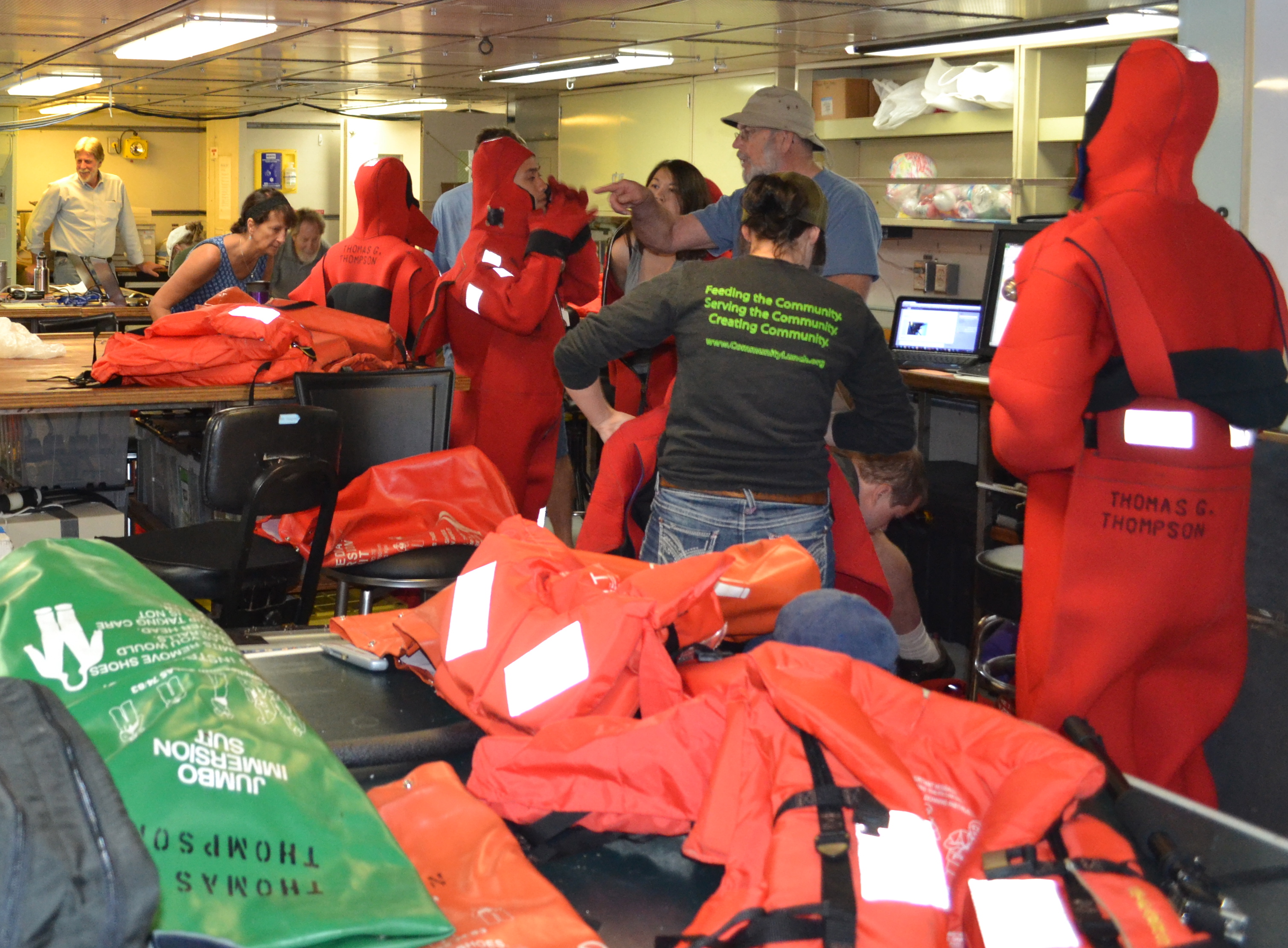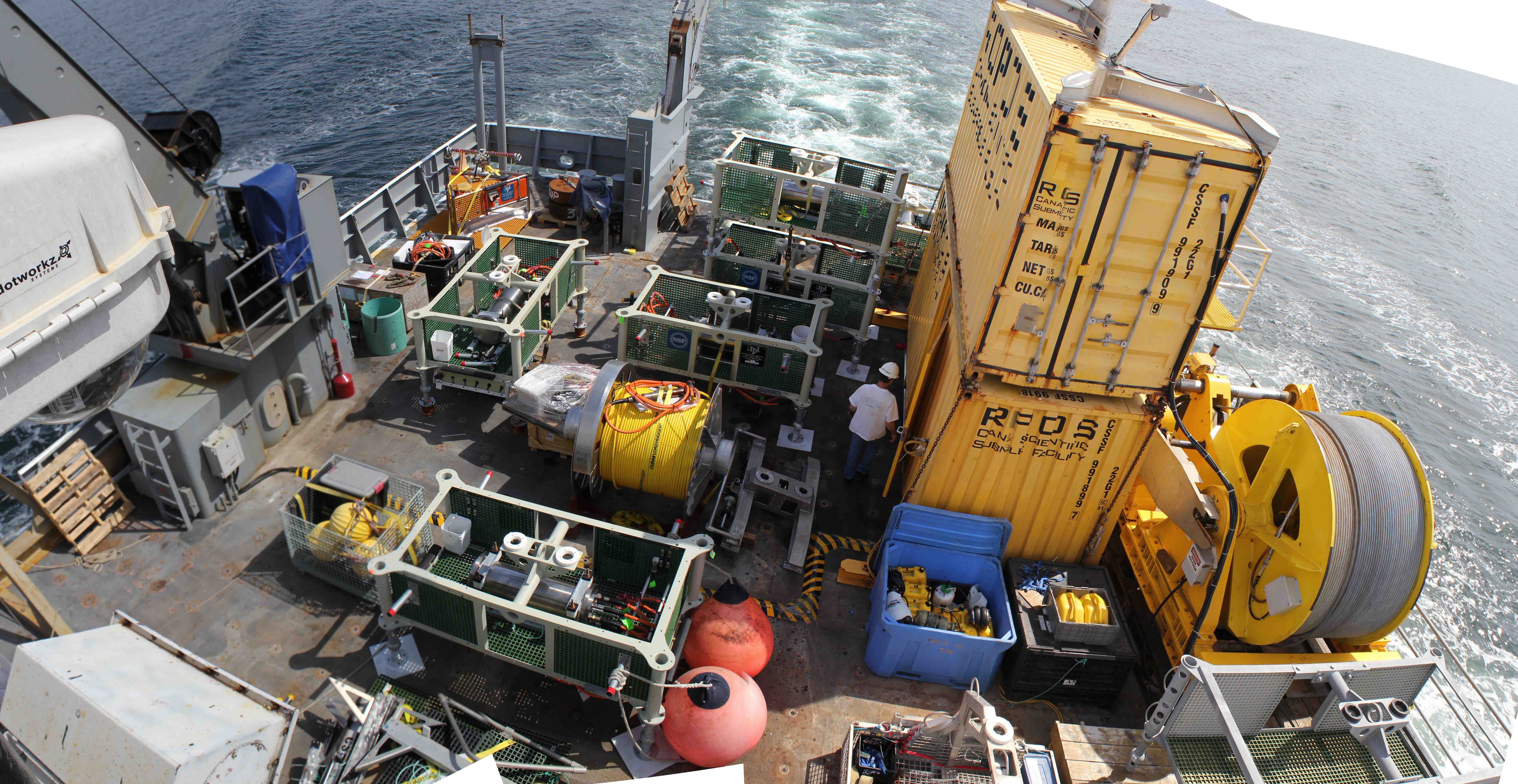Image Archive





























Friedrich Knuth, a graduate student at the College of Charleston, models the latest in ocean survival wear. Photo credit: Mitch Elend, University of Washington, V14.

The final game of the 2014 World Cup (Germany vs. Argentina) was in action the VISIONS '14 expedition pulled away from the Seattle dock. Following one of the safety drills, Univeristy of Washington and College of Charleston participants watched the exciting match. Photo credit: Leslie Sautter, College of Charleston, V14.

University of Washington students Krista Nunnally, Gina Hansen and Sam Albertson show their excitement for going to sea aboard the R/V Thompson at the start of the VISIONS '14 Expedition. Photo Credit: Leslie Sautter, College of Charleston, V14.

On the transit out to Axial Volcano, a short stop was made to conduct a "Dunk Test" with the ROV ROPOS to ensure all was ready to go upon arrival at Axial Seamount. Image Credit: Mitch Elend, University of Washington, V14.

Sam Albertson, Don Setiawan, and Katie Bigham look out to the west, awaiting the departure of the R/V Thompson from Seattle. Photo Credit: Mitch Elend, University of Washington V14.

Staterooms on the R/V Thompson are our home for the duration of the cruise. They include two berths (beds), dressers and closets. Photo credit: Joh Worley, Clallam Bay School, V14

The R/V Thomas G. Thompson departed from Pier 90 in Seattle for the first leg of VISIONS '14. Photo credit: John Worley, Clallam Bay School, V14.

As part of the safety drills, all participants must practice getting into the thick orange rubber immersion suits, also called "Gumby Suits." Photo credit: Mitch Elend, University of Washington, V14.

University of Washington student Landung "Don" Setiawan began his project before the ship sailed, taking time-lapse photos of various onboard operations. Photo credit: Mitch Elend, University of Washington, V14

University of Washington, School of Oceanography undergraduate, Jesse Turner, practises getting into a "gumby" suit during a safety meeting onboard the R/ V Thomas G. Thompson. Photo Credit: Mitch Elend, University of Washington, V14.

Panoramic view of the R/V Thompson fantail as it departs for Axial Seamount on the VISIONS'14 OOI expedition. Green-sided frames are junction boxes that will be installed at the volcano and they willl host myriad instruments. The central drum holds yellow extension cable that will connect one of the juction boxes to Primary Node 3B, providing power and bandwith to this subsea observatory. Photo credit: Skip Denny, University of Washington, V14

The first night of VISIONS'14 on the R/V Thompson at Pier 90, downtown Seattle, was blessed with beautiful skies and a super moon.

Charles Garcia is an undergraduate student in the School of Oceanography, University of Washington. He is on Leg 1 of the VISIONS'14 expedition.

VISIONS'14 students onboard the R/V Thompson their first night. From left to right: Don Setiawan, Gina Hansen, Jesse Turner, Kaite Bingham, Sam Albertson, Krista Nunnally, and Charles Garcia.

A super moon rises over Seattle as observed from the University of Washington's research vessel the R/V Thompson. A fine send off to the start of an 84-day expedition to complete the installation of the U.S. first underwater high power and bandwidth cabled observatory. Photo credit: Skip Denny, University of Washington, V14.

A composite of ocean circulation, seafloor bathymetry, tectonic plate boundries, and world population. Composite created by Center for Environmental Visualization.

Mobilizing ROPOS at Pier 90 in Seattle, July 11, 2014 Photo credit: Debbie Kelley, University of Washington

Neruda: It Is Born

Rachel Carson

Quinlan Lonergan

Ryan Brennan

Katie Bigham

Taylor Faubion

Rachel Hubbard

Marine Lebrec

Brendan Philip

Ian is a sophmore at the University of Washington in the Department of Earth and Space Sciences.

The Oregon Inshore Site will host both cabled and uncabled infrastructure. During the VISIONS'14 cruise, it is anticipated that a Surface Piercing Profiler system, a Benthic Experiemtal Platform, and associated instruments will be installed.
- Anemone
- Animal
- Arthropod
- ASHES
- Axial
- Axial Base
- Axial Biology
- Axial Caldera
- Bacteria
- Basalt Lava
- BEP
- Biofouling
- biolgoy
- Biology
- Camds
- Camera
- Camhd
- Central Caldera
- Ciliates
- Cnidaria
- Coastal Biology
- Crab
- Deep Profiler Mooring
- Dive Highlights
- Eastern Caldera
- Echinoderms
- Endurance Array
- Engineering Team
- ENLIGHTEN 10
- Exploratorium
- Fish
- Geology
- HD Camera
- HPIES
- Hydrate Ridge
- Hydrates
- Hydrophone
- Hydrothermal Vents
- Illustration
- Inshore 80 Meters
- Instrument
- International District
- J-BOX
- Jason
- Jellyfish
- Junction Box
- K12
- Lava
- Mollusk
- Moorings
- Nodes
- Nudibranch
- Octopus
- OOI
- Oregon Offshore
- Oregon Offshore 600 m
- Oregon Shelf
- Oregon Slope Base
- People
- PN1B
- PN1D
- Polychaetes
- PPSDN
- Primary Node
- RASFL
- ROCLS
- ROPOS
- ROPOS Dives
- ROV Team
- RV Revelle
- RV Sikuliaq
- RV Thompson
- Salp
- Sample
- SC13
- Science Team
- Sea Cucumber
- Sea Star
- Sea Urchin
- Seafloor
- Seismometer
- Sensors
- Shallow Profiler Mooring
- Shark
- Shipboard
- Shore Station
- Slope Base
- Smoker
- Soft Coral
- Southern Hydrate Ridge
- Sponge
- Squid
- Students
- Students & Guest Participants
- Tmpsf
- Tubeworms
- VISIONS 11 Leg 1
- VISIONS 11 Leg 2
- VISIONS 11 Viewers
- VISIONS 13
- VISIONS 14
- VISIONS 15
- VISIONS 16
- VISIONS 17
- VISIONS 18
- VISIONS 20
- VISIONS 22
- VISIONS 23
- Visualization
